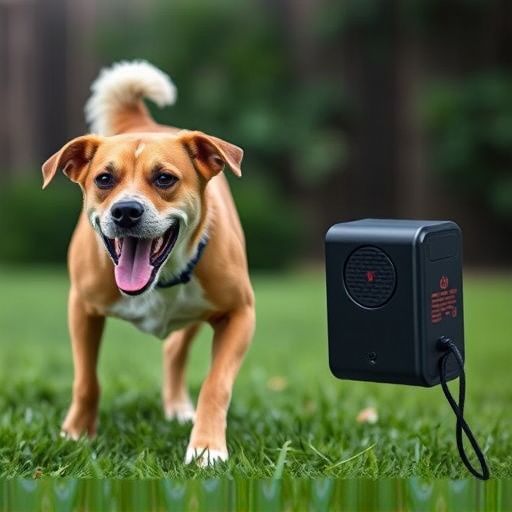Ultrasonic dog repellents provide a humane and effective solution for managing aggressive pets, leveraging inaudible high-frequency sound waves to deter unwanted behavior. With customizable Dog Repellent Modes, these devices offer tailored training options, from continuous emission to motion-activated triggers. Proper placement and safety testing are crucial, while positive reinforcement techniques enhance their effectiveness. Consistent training across various settings ensures successful generalization for real-world applications of these innovative tools designed for peaceful coexistence between humans and their furry friends.
“Unleash a safe and effective solution to dog behavior issues with ultrasonic technology. This innovative approach offers a non-toxic, sound-based method to repel dogs without harm. Our article delves into the science behind ultrasonic dog repellents, exploring different modes and their effectiveness against aggressive pets. We’ll guide you through safety considerations and provide practical tips for implementation. Discover how this cutting-edge technology can transform your outdoor spaces while addressing behavioral challenges.”
- Understanding Ultrasonic Technology for Dog Repellents
- Types of Dog Repellent Modes: An Overview
- Effectiveness and Safety Considerations
- Training and Implementation Tips for Aggressive Pets
Understanding Ultrasonic Technology for Dog Repellents
Ultrasonic technology has emerged as a popular and effective solution for dog repellents, offering a safe and humane way to deter unwanted canine behavior. This innovative approach utilizes high-frequency sound waves that are inaudible to humans but can be sensed by dogs. By emitting these ultrasonic signals, the devices create an unpleasant sensation, encouraging dogs to avoid certain areas or behaviors.
One of the key advantages is its ability to target specific dog repellent modes, especially for aggressive pets. These technologies emit different frequencies and patterns, allowing users to customize the settings according to their needs. Different ultrasonic repellents may have multiple modes, such as a continuous high-frequency tone or rapid pulses, which can be adjusted based on the pet’s response and environment. This versatility ensures that dog owners can find the most suitable solution for their aggressive dogs, promoting a peaceful coexistence between humans and their furry friends.
Types of Dog Repellent Modes: An Overview
Ultrasonic dog repellents have gained popularity as a humane and effective way to deter dogs from specific areas, especially those with aggressive tendencies. These devices operate on the principle of emitting high-frequency sound waves that are unpleasant to dogs but often imperceptible to humans. The market offers various Dog Repellent Modes tailored for different scenarios and pet behaviors.
One mode focuses on training and positive reinforcement, using ultrasonic signals in conjunction with a spray or visual cue to teach dogs to avoid certain zones. Another advanced mode employs motion sensors to trigger the ultrasonic emission only when a dog enters the defined area, minimizing false activations and conserving battery life. For aggressive pets that require constant monitoring, a continuous mode emits ultrasonic waves consistently until the pet leaves the area, providing a reliable barrier.
Effectiveness and Safety Considerations
The effectiveness of ultrasonic dog repellents lies in their ability to emit high-frequency sound waves that are unpleasant or even painful to dogs, encouraging them to steer clear. These devices often offer multiple repel modes, catering to different aggression levels in pets. For mildly aggressive dogs, a single, consistent frequency might suffice. However, for more persistent or severely aggressive canines, advanced models provide adjustable settings, allowing users to target specific frequencies that best deter their pets without causing harm.
Safety is a primary concern when using any dog repellent, especially ultrasonic devices. While generally considered safe for humans and pets when used according to instructions, thorough testing is crucial to ensure no adverse effects on sensitive dogs or individuals with respiratory conditions. Repellents should be placed strategically, away from the reach of curious pets and children, to prevent accidental activation and potential discomfort.
Training and Implementation Tips for Aggressive Pets
When dealing with aggressive pets, using an ultrasonic dog repellent can be a game-changer, but proper training and implementation are key. The technology emits high-frequency sound waves that are inaudible to humans but irritating to dogs, offering a safe and humane way to deter aggressive behavior. To maximize its effectiveness, it’s crucial to understand the different dog repellent modes these devices offer, such as continuous or intermittent activation, allowing you to tailor the training experience according to your pet’s needs.
During training, start by introducing the ultrasonic device in a controlled environment, letting your pet get accustomed to the sound. Gradually increase the sensitivity and duration of activation over time, reinforcing positive behavior with rewards when they remain calm. Consistency is vital; ensure all family members use the same activation mode and follow a structured routine. Regular practice in various settings will help generalize the training, making it more effective for real-life situations where your pet might display aggression.
Ultrasonic technology offers a safe and effective solution for deterring dogs, particularly aggressive ones. By understanding how this technology works and choosing the right mode from the various dog repellent options available, pet owners can humanely train their pets to stay away from unwanted areas. While safety considerations must be made, extensive research indicates minimal risk when using ultrasonic devices. With proper training and implementation tips tailored to each pet’s needs, these innovative tools can significantly improve living environments for both animals and their owners, providing a peaceful solution to managing aggressive canine behavior.
